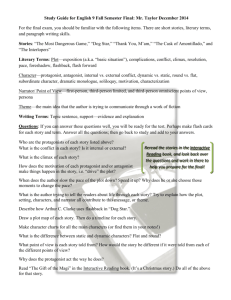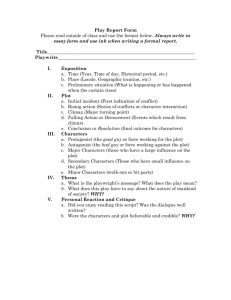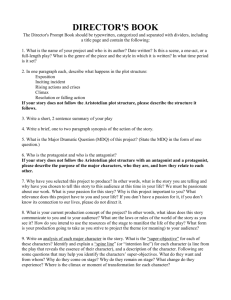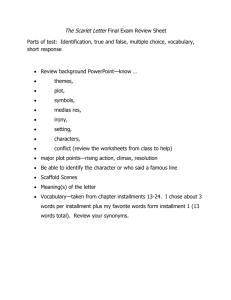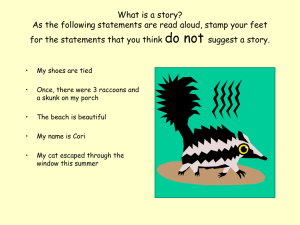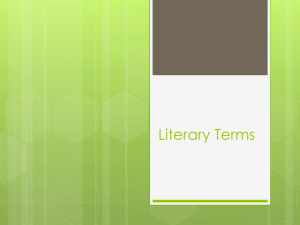slides through day 4
advertisement
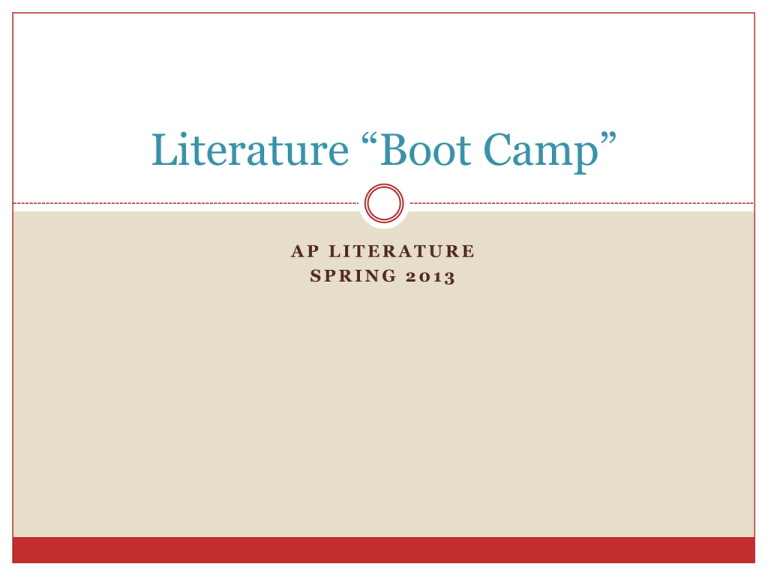
Literature “Boot Camp” AP LITERATURE SPRING 2013 Plot DAY 1 Plot Is what happens in a narrative More than series of events Authors must arrange conflicts, complications and resolutions to create logical cause-and-effect relationships. Must understand not just what is happening but WHY it’s happening 5 Main Stages Climax Denouement Exposition Provides background information about the characters, setting, and situation, describe the nature of the conflict Rising Action After an inciting incident, the conflict and complications for the main character begin to build. Climax Occurs when emotional tension or suspense of the plot reaches its peak. May include a turning point where the fortunes of the protagonist improve or worsen. Falling Action Details the result or fallout of the climax or turning point. The conflict gets resolved. Denouement (Day-noo-mah) French for “untying the knot” Brief phase, the conflict has been resolved and balance is restored to the world of the story. Fairy tale “And they lived happily ever after.” Used to tell the moral of the story but 20th and 21st century – readers are left to ponder the possible meaning Misc. May follow a chronological sequence, but sometimes writers deliberately present events in a manner that requires readers to assemble them into a cohesive pattern. A story may begin “in medias res,” meaning “in the middle of the action” or writers might employ a flashback to describe events that have taken place before the story begins or foreshadowing to hint at things that might happen later in the story. Questions to help analyze plot 1. 2. 3. 4. 5. 6. 7. 8. 9. Is the plot arranged in chronological order, or does it begin in medias res? Does the plot involve a flashback? If so, what is its purpose? What conditions at the outset make the situation unstable? What is the nature of the conflict? Is the conflict external or internal? What is the high point, or climax? How is the conflict resolved? If there is no resolution, why not? Is there a denouement? If not, why is the story inconclusive? What patterns do you find in the plot’s structure? Assignment for “The Jewelry” In groups of 4 – discuss the following – you will have 15 minutes then we will discuss as a class. 1. Create a plot structure 2. Discuss the questions on the previous slide 3. Once the secret of Madame Lantin’s jewelry is revealed, what details from earlier in the story take on a different significance? 4. How and why might the story’s end – especially its last paragraph – defy expectations? How does it once again change your interpretation of earlier events and of Lantin’s first marriage? Homework Setting DAY 2 General Information Indicates the time and place, the when and where Includes objective facts such as Nation or town Date and time Weather and season What does setting tell us about the plot? A Dark and Stormy Night A Spring Morning with lots of Sunlight A farm house in Maine An internment camp in Germany How setting relates to meaning Establishing a contrast between a different setting is being ironic. You will have to consider the thematic significance of things that might at first seem merely physical and objective Most important thing pay attention to the details The sights and sounds Textures and tones Colors and shapes Historical Context A time and place that has its own political, economic, or social upheavals Usually goes unstated – author expects the reader to bring to the book. Sometimes historical setting are not implicit but explicit – with dates and places clearly indentified Cultural Environment Setting may also establish the cultural environment of a work – the manners, mores, customs, rituals, and codes of conduct Sometimes cultural environment is based on an actual period, culture, or community – sometimes authors make or invent new cultures Questions to help analyze setting What is the geographical setting? The time, place, weather, season? Why is it important? 2. What historical context or social environment is being depicted, and what background information is required to understand the situation? 3. What details of the setting does the author use to create atmosphere or mood? 4. How does the setting seem to relate to the themes? 1. Assignment for “The Lady with a Dog” In groups of 4, discuss the following, we will discuss as a class. Discuss the questions from the previous slide. Yalta, where “the Lady with the Dog” opens is a resort on the Black Sea, Moscow, where Gurov lives, is described at the beginning of section III. To what extent do the settings relate to the events and emotions of the story? How do other details – such as the watermelon is section II and the slightly “off” sturgeon in section III – relate to the settings and attitudes and feelings associated with the places? Which are conventionally assumed to be more real, the feelings we have on holiday (vacation) or those in our everyday lives? How is this convention related to our expectations about the outcome of the story? To the meaning of the story? Homework Read and annotate “Barn Burning” by William Faulkner When and where is the story occurring? How does Faulkner convey this information to you? Character DAY 3 General Information Goes hand-in-hand with plot because the conflict that structures a plot usually arises between two or more characters External conflict – usually has a protagonist and an antagonist Internal conflict – characters struggles with temptation or tries to reconcile two incompatible traits. Main characters grow or change over the course of the story – sometimes they change structures the plot. More info For a character’s growth to be believable, it must be clearly motivated by the circumstances of the story. Sometimes the change is gradual and sometimes it is sudden – epiphany 3 categories of characters Round (or dynamic) – usually protagonist exhibits a range of emotions and changes over the course of the story – multiple personality traits and thus resemble real people Flat characters (or static) embody only one or two traits and provide a background for the protagonist’s actions Common type is called a foil – a contrasting character who allows the protagonist to stand out more distinctly Stock characters may represent stereotypes, such as the absent-minded professor or the town drunk occasionally providing comic relief. How author’s reveal character Either – directly or indirectly Direct characterization occurs when a narrator explicitly describes the background, motivation, temperament of appearance of a character. Indirect characterization occurs when an author shows rather than tells us what a character is like through what he or she says, does, or thinks, or what others say about the character. Questions to help analyze characters 1. 2. 3. 4. 5. Who are the main characters in this story? Who is the protagonist? Who is the antagonist? What do we know about them? What is their relationship to each other? How do they change from beginning to end? What is the function of the minor characters? Do some characters see themselves differently from the way readers see them? If so, how?

